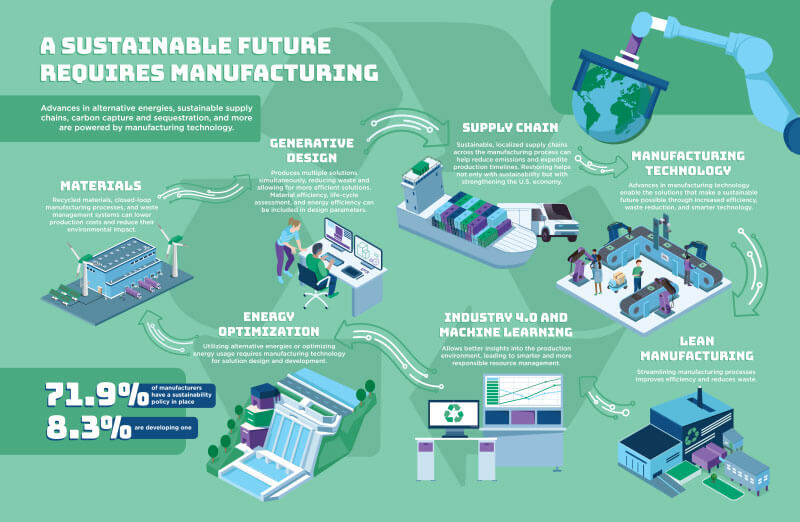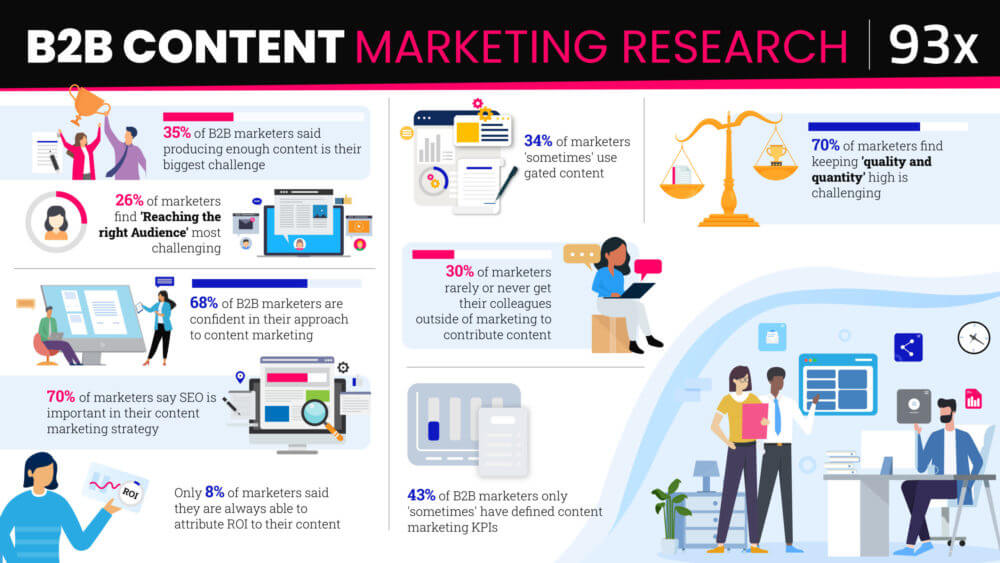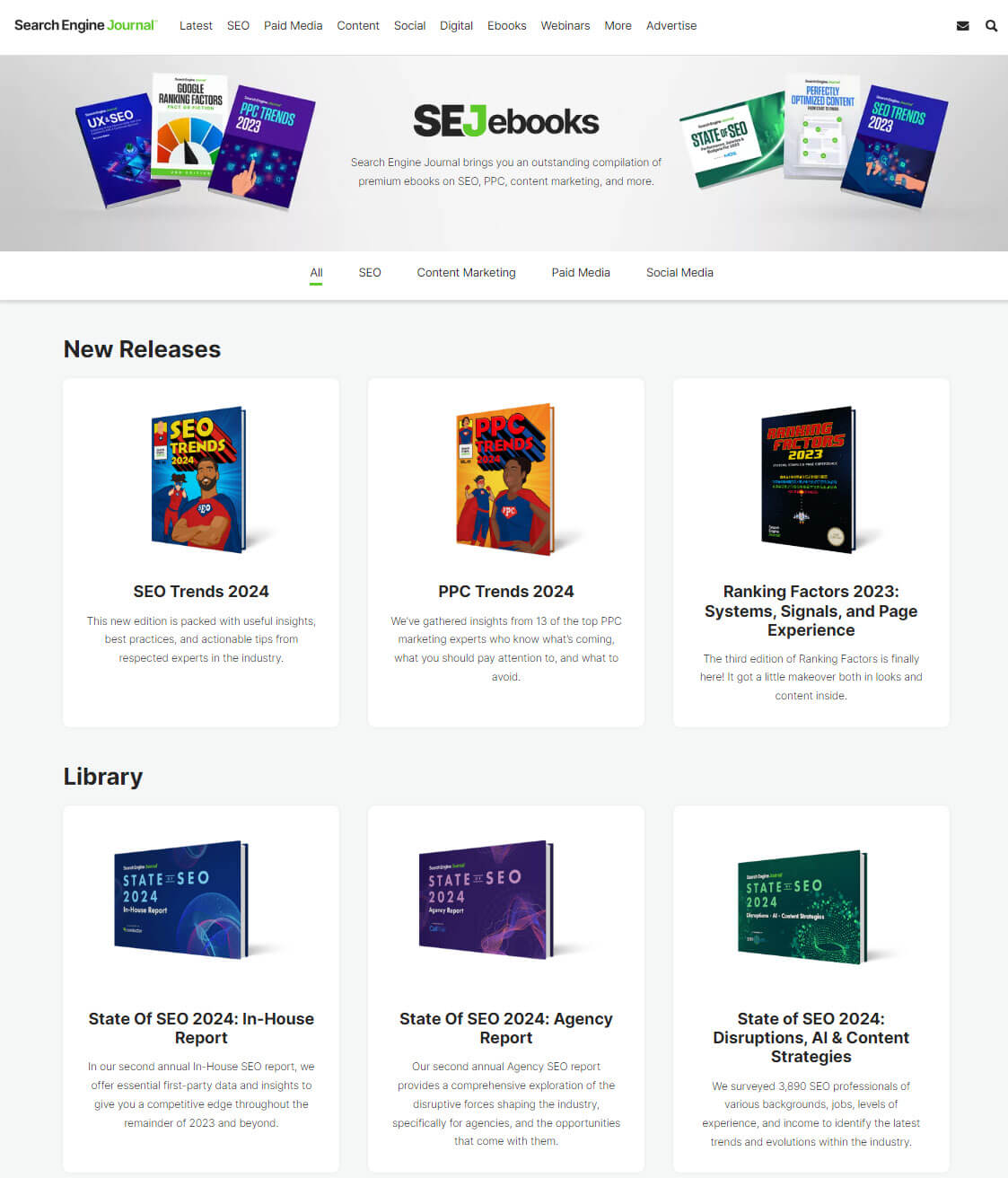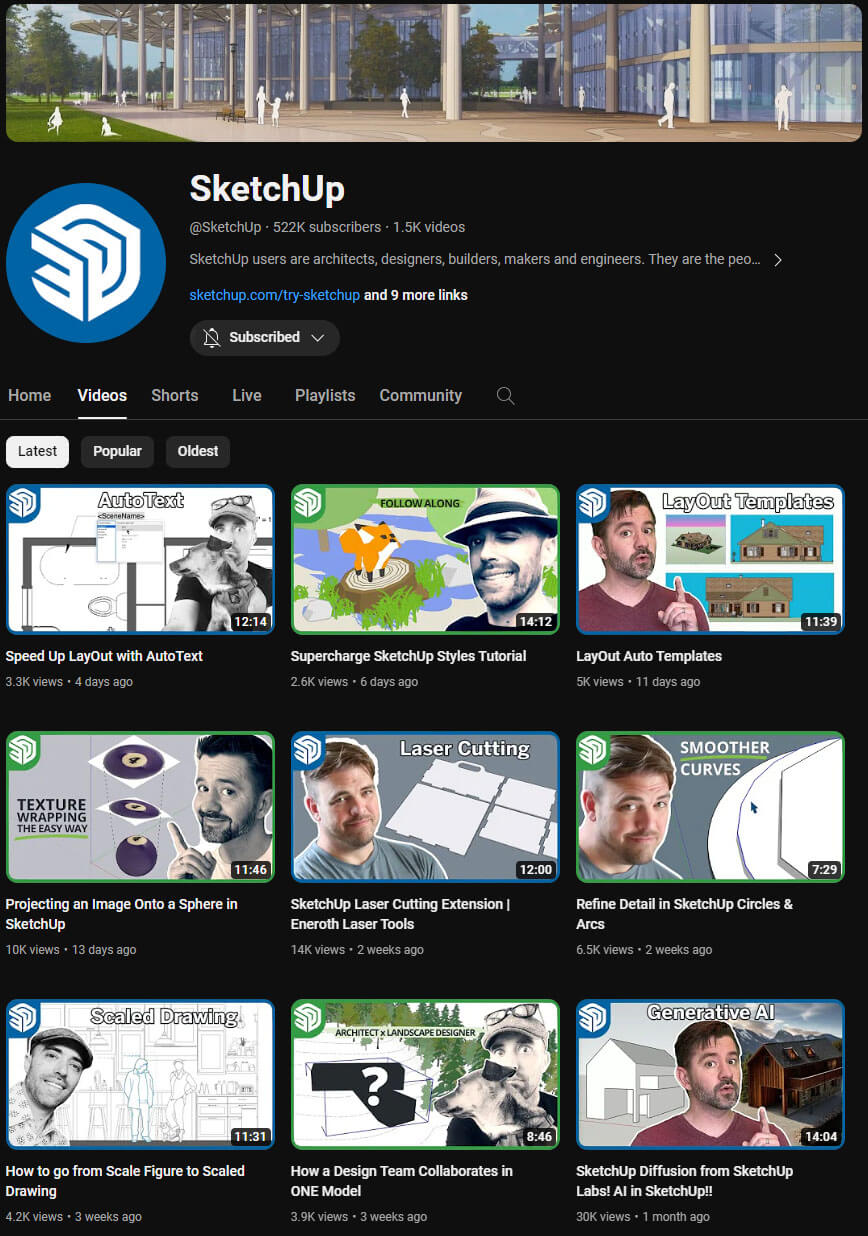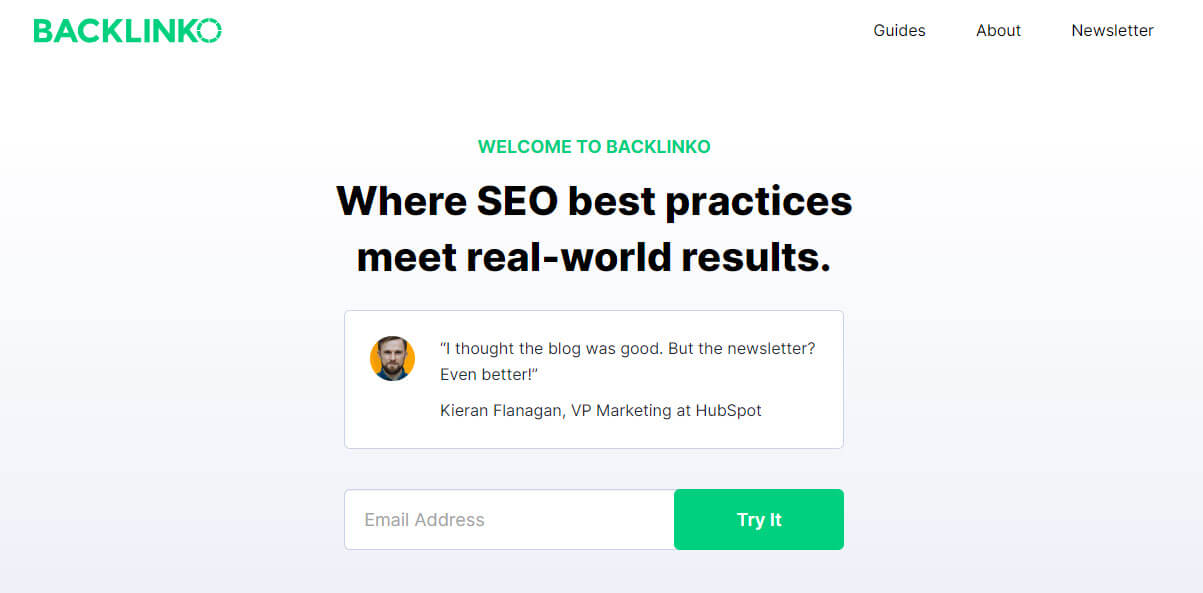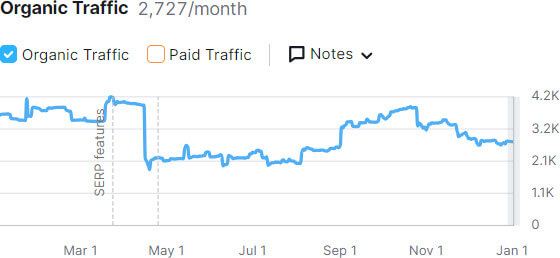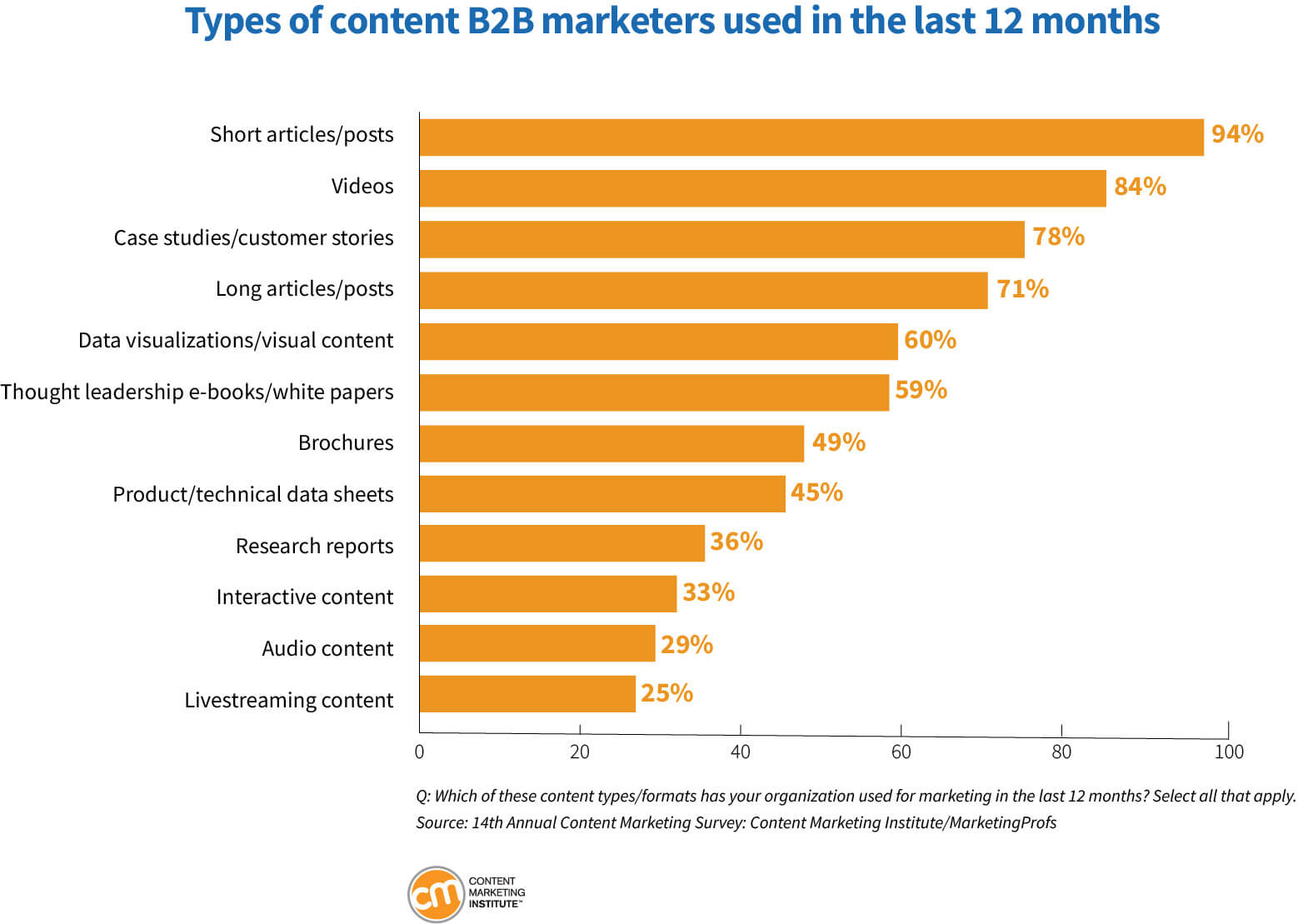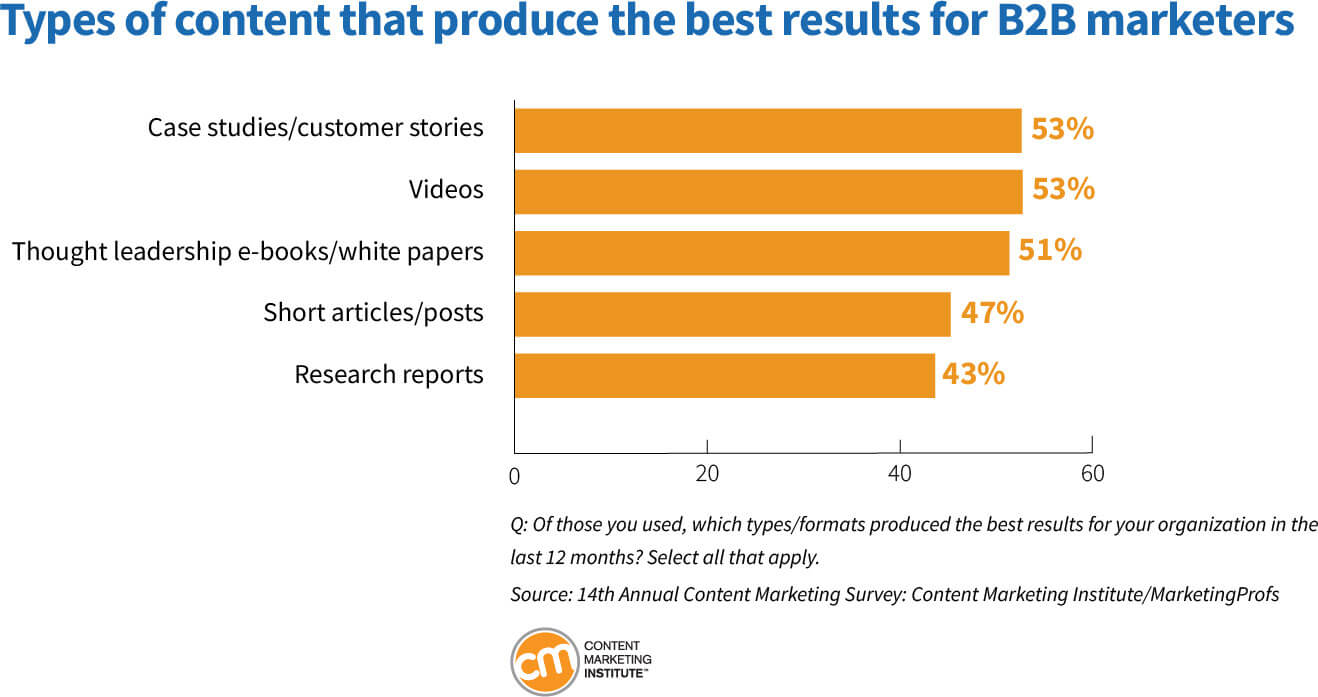The traditional B2B landscape of aggressive pitches and forced sales tactics is fading. Today, success hinges on building trust, fostering meaningful relationships, and delivering genuine value. This is where content marketing plays a role to transform your lead generation and customer acquisition strategies. From data-driven white papers establishing your thought leadership to user-generated content igniting trust, we’ll equip you with the tools to weave a compelling narrative that resonates with your target audience. Let’s look at the 11 types of content marketing to use in your B2B strategy:
What is Content Marketing?
Content marketing is a form of inbound marketing strategy where businesses create, generate and promote content online. By “content”, it is not focused solely on news or blog posts all the time, but it includes a combination of text, images and videos that create an engagement content to attract a dedicated market.
Content marketing is one form of marketing strategy that is sustainable for retention and brand relevancy online. It helps navigate customers from awareness to the conversion phase without advocating hard selling methods to do so.
Why Content Marketing is Important?
Resonating from earlier reasoning, one of the things that make content marketing a valuable business strategy is sustainability. It does not wither with time. The point of interaction to any form of content marketing does not end during the first visit, it is versatile enough to become an evergreen content that will help each stage of the funnel.
Content marketing campaigns specifically boost engagement rates between businesses and customers, be it business-to-business or business-to-consumer. The significance for both ecosystem remains the same. What differs is the type of content marketing format and structure that should align to your business module. It is important to known which type of content you want to use for your messaging.
Social Media
Social media is a suitable platform to engage with your audience as a method to nurture the relationships between your business and clients, apart from promoting your content in a more organic environment. Platforms like LinkedIn, Facebook, Instagram, YouTube, TikTok and many others are now the playing field for B2B marketers to run their social media marketing campaign to build their awareness and double their ROI.
Businesses can leverage social media platform’s features to display insightful LinkedIn polls, collaborating on Instagram reels showcasing client projects, or creating educational YouTube series with industry experts. This emphasises the relationship-building aspect of social media beyond content promotion – preserving long-term partnerships for retention.
Infographics
Infographics are the visual representation of complex information with the use of graphs, funnels, icons and charts. It is an interesting way to break down even the most complicated concepts as the incorporation of visual elements in it allows readers to comprehend the information easily.
Take the two infographics about sustainable manufacturing and content marketing research statistics shown for example. From a simple infographic alone, general audiences will get an understanding about the general context of each topic without trouble even though the topic is very niche-focused. The information provided is cohesive, concise and attractive with the use of creative visuals numbing down the complex information.
Emails
Email is an electronic mail that is most commonly used to communicate between organisations and stakeholders, but it is also a power content marketing tool. Email marketing is a beneficial tool for nurturing leads and staying in touch with your subscribers.
Businesses can use emails to send newsletters, reports, promotions, and other valuable content to your subscribers who consist of key decision-makers. This is the best way to maintain interest of your potential clients to your business during the nurturing phase, which we know can typically stretch for a year or more.
Email remains a B2B content marketing option, especially during the nurturing process is due to its targeted reach. You can be very flexible and targeted with your content when you are using email marketing as a medium. It also have lead nurturing ability, measurable results, cost-effectiveness, and brand-building potential that make it a must-have for effective campaigns.
Ebooks
Ebooks are long-form pieces of content that offer in-depth information on a specific topic. Ebooks can be used to educate potential customers about your industry, your products or services, or the challenges they face.
Ebooks can be a mere 5-pages ebook to 150-pages ebook, depending on the topic you discuss. Is it better to have as little or as many pages? It depends on the depth you want to cover for your topic, there is no official rule to measure the thickness to its conversion rate. The value of the content is what guarantees conversion.
Tech companies like Google, Search Engine Journal, Ahrefs, and many others utilise this type of content marketing to promote their services and showcase their value to potential clients and consumers. It not only helps receivers of these ebooks to have a direct guide on the products and services they are actively using from the establishment themselves, but it positions the businesses that publish these ebooks as knowledge experts in the field – promising long-term business-to-client relationship and future conversions.
Paid Ads
Paid ads are utilise when businesses stream capital resources into advertising on search engines, social media platforms, and other websites to meet specific goals. It can be a great way to reach a wider audience and drive traffic to your website. Paid ads can be targeted to specific demographics and interests, making them a very effective way to reach potential customers.
This level of customisation ensures that the content is presented to potential clients who are more likely to be interested in the products or services being promoted. By optimising targeting parameters, businesses can increase the efficiency of their ad campaigns, thereby maximising the return on investment.
In essence, using paid ads represents a dynamic and powerful tool in the modern marketing landscape. Strategically investing resources in online advertising, businesses can not only expand their reach but also connect with a highly targeted audience, ultimately driving traffic, increasing brand visibility, and contributing to overall business growth.
Video
Video is a powerful type of content to strike engagement rate from your viewers. Videos can be used to explain your products or services, showcase customer testimonials, or offer thought leadership on industry trends. 91% businesses see uplift in their ROI from video-based marketing in 2023, and with over 2.7 billion users access YouTube once a month, the business opportunity in video-based content will remain relevant in the coming years.
For SketchUp, they use video content to provide tutorials and demonstrate new features related to their own digital sketching tool. This type of content allows viewers to learn and understand the product better and not to mention the promotional value these content help to introduce this product to a larger market. It also boost organic growth when people began to share the videos on other social media platforms.
User-generated Content
User-generated Content or UGC are contents created by your target market, such as customer stories and social media posts. User-generated content is seen as more authentic and trustworthy than traditional marketing materials, and it can help you build trust with potential clients.
Like we mentioned in the beginning of the article, in today’s B2B landscape, building trust and exceeding expectations are critical. Leveraging real customer experiences, testimonials, and social mentions as social proof fosters increased trust and brand credibility. UGC is a powerful content amplifier that could expand your reach to larger market, industry leaders and product experts.
Blogs
Blogs are a singular or series of articles published on a business’s website covering various topics from business insights, product reviews, news and many more. Blogging might seemed a traditional marketing tool by now, but it still holds its ground in 2024. People still finds value in written content due to its in-depth breakdown of a topic and it’s SEO-value to promote your business organically with very low-cost production investment.
When a search engine takes interest in the blogs related to your brand, product and services that your business produces, it can increase your brand’s value and display them frequently in the Search Engine Result Pages (SERPs).
Backlinko is a prime example of showing how blog is still relevant in today’s day and age. This site is a library of blog articles about various topics related to SEO, digital marketing, content marketing, paid marketing and more. It maintains a steady average of 2k organic traffic each month and this translates a clear value and demand for long-form content type.
Free Offers (Tools & Service Demo)
Offering free tools, resources, or service demos is a great way to generate leads and attract potential customers and partnerships wtih clients. Free offers can help you build trust and credibility with potential clients, and these offers can give them a taste of what your products or services can do.
This low-pressure, high-value approach positions your brand as a reliable partner, not just as a salesperson looking for immediate buy-ins. By demonstrating what your product or services offer without visible commitments, it helps to pave the way for long-term, mutually beneficial relationships. By removing the risk and igniting curiosity, free offers not only capture leads but nurture them into qualified prospects, primed for conversion.
Case Studies
Case studies are real-world examples of how your products or services have helped other businesses, or an observation to a specific idea or concepts that could be insightful for specific industries. Case studies can be used to build trust and credibility with potential customers, and to demonstrate the value of your offerings.
Contern Marketing Institute provide an interesting insight in their 2023’s B2B Content Marketing research where they indicated that the use of case studies increase to 78% compared to the previous 12 months by B2B businesses. Furthermore, the research also found case studies to be the type of content that generates the best results – overperforming ebooks, white papers, short-form contents.
Companies like Content Marketing Institute not only provide valuable insights to the B2B ecosystem as a whole, but the regular publication of research papers nad case studies like the one we cited earlier put credibility in their own company as well to be one of the thought leaders when it comes to in-depth research about the market, be it B2B or B2C. This is the potential outcome businesses can leverage when it comes to using case studies as part of their content marketing strategy.
White Papers
White papers are in-depth reports that provide expert analysis on a specific industry issue or challenge. White papers are a great way to establish yourself as a thought leader and to attract qualified leads. What differs white papers from ebooks or case studies, you might wonder? White papers are very heavily data-oriented and target highly qualified leads seeking in-depth analysis and solutions.
They present complex information in a structured and logical format by incorporating charts, graphs, and visuals to enhance understanding. By leveraging the power of data, insightful analysis, and persuasive storytelling, white papers can propel your B2B marketing strategy to new heights, attracting, nurturing, and converting the most valuable leads into dedicated customers.
Final Takeaways
Nurturing leads and getting buy-ins from businesses is no longer a process made only through endless meetings and long phone calls. Content marketing could help foster those phases better by diversifying the types of content you can use to approach potential clients.
However, it is important to know which types of content marketing to use for which objectives. It is not a one-shoe-fits all allegory, but it requires a little time in the changing room to see what fits you. Leverage each type under different situations to learn which works better for your objective.
Content marketing not only promotes your brand by growing its online presence and generates organic traffic long-term, but it allows you to broaden your reach across channels. This gives you better opportunities to grab the right leads that could translate into a quality ROI for your business.

